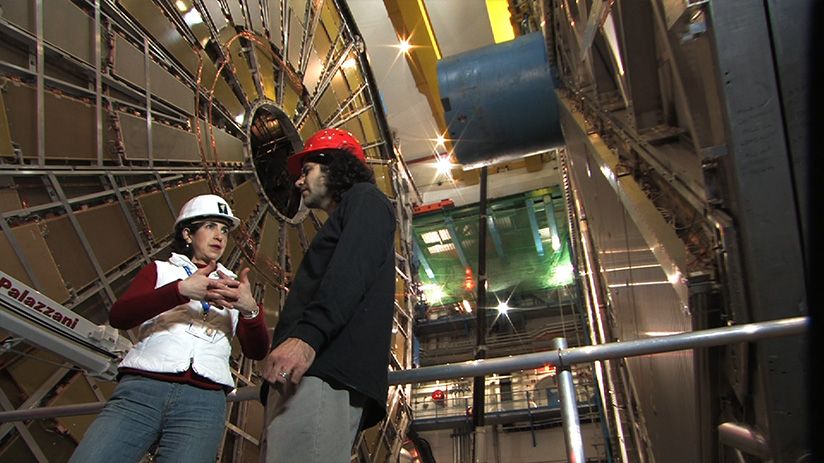Art and Science Collide in the Discovery of the Higgs Boson
Particle Fever, a documentary about the physicists who found the “God particle,” suggests doing science isn’t that different from making art
What do ancient cave paintings, Renaissance frescoes and Cubist sculptures have to do with the discovery of the Higgs boson?
Quite a lot, says theoretical physicist Savas Dimopoulos. "Why do we do science? Why do we do art? It is the things that are not directly necessary for survival that make us human."
Dimopoulos gives this thought-provoking commentary as parting words in Particle Fever, a new documentary produced by Anthos Media and distributed by BOND360. Particle Fever chronicles the lives of the scientists behind the monumental discovery of the Higgs boson in 2012. From a particle physics perspective, there's no greater question than the existence of the Higgs. Theorized in 1964, the so-called "god-particle" was at the center of the standard model—the accepted theory of how tiny subatomic particles interact.
Particle Fever opens during the construction of the Large Hadron Collider (LHC), the gigantic machine used to search for the particle at the European Organization for Nuclear Research, better known as CERN. Leading up to the discovery, the narrative follows chronological highlights at the LHC, including the testing of the machine, a major problem with a helium leak, and the first time they tried to smush two particles together using the machine.
Though the film deals with some pretty hard science, it strives to depict a very human struggle for understanding. The same struggle is also reflected in the art world, according to director Mark Levinson—both science and art, he says, are human attempts to represent and reveal more about the world. So while the film tells the story of the Higgs boson's monumental discovery, skillfully woven through it are parallels between science and art.
One of the ways Levinson highlighted these parallels was by capturing scientists' reactions to art. In a comedic scene in Particle Fever, David Kaplan and fellow theorist Nima Arkani-Hamed contemplate an art installation outside the Institute for Advanced Studies at Princeton University in New Jersey. The sculpture entitled, "Slate Oasis," is made up of lots of small red and blue slabs of slate arranged in a courtyard. The filmmakers use the sculpture to help explain how the Higgs fits into the standard model, which says everything is made up of four fundamental particles and those particles interact through four fundamental forces.
But beyond highlighting analogies with art—which can be useful for explaining science—the film also shows that conducting physics research is in many ways an artistic process.
"We’re trying to figure out a deeper theory of nature and that process is really a lot of guess work," says Kaplan, a researcher at Johns Hopkins University in Baltimore and the movie's producer. "You take hints, you follow leads, but you’re also being very creative and trying to figure out what it could be, and try to imagine things that aren’t in the current theories but that could be. You have to have an incredibly open mind to push through that process, and so the process itself actually feels very artistic, at least in relation to what my artist friends talk about going through."
The film follows a variety of scientists through this process: from the scientists who keep the LHC up and running like beam operations leader Mike Lamont, who makes sure the LHC's beam and injectors are all running smoothly; to experimental physicists Monica Dunford and Martin Aleska who work specifically on the ATLAS (short for "A Toroidal LHC Apparatus") project, one of five LHC experiments at CERN; to theorists Dimopoulos, Kaplan, and Arkani-Hamed whose abstract ideas will be tested using the five-story machine. Outside of their day jobs, several of the researchers dabble in the arts. But the champion of the art-science connection is ATLAS spokesperson Fabiola Gianotti.
Gianotti is a classically trained pianist. In college, she studied physics and music simultaneously, and she has retained her love of both. “Music remains a central part of my life,” says Gianotti. “It's always with me, even when I don't play or listen. It's in my mind all the time.”

In the film, we watch Gianotti play the piano with passion and precision at home after long hours probing the nature of the universe at the lab. Gianotti's love of music shows that hard-hat wearing experiemntal physicists have lives outside of the research lab, but it's also clear that the same artistic tools of dedication and creativity shape scientific endeavors.
The film, particularly how it weaves in art, also provides a human face to a field that for some reason has an inhuman reputation. "Honestly people see artists as perhaps more approachable and human than scientists, for better or for worse," says Levinson. Thus, the film itself is proof that through art, science can become more than the stereotypical network of esoteric theory, jargon and experiments, because at its core science is a personal search for truth.
/https://tf-cmsv2-smithsonianmag-media.s3.amazonaws.com/accounts/headshot/Screen_Shot_2014-01-27_at_12.05.16_PM.png)



/https://tf-cmsv2-smithsonianmag-media.s3.amazonaws.com/accounts/headshot/Screen_Shot_2014-01-27_at_12.05.16_PM.png)